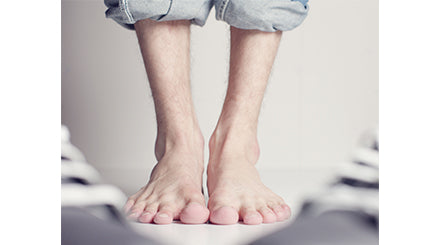
How Proper Footwear Can Help You Avoid Contracting Athlete’s Foot
Tinea pedi, better known to most of us as "Athlete's Foot," is a common foot condition that is caused by a fungal infection. The fungus thrives in warm, damp environments such as pools, locker rooms and shared showers, which are especially susceptible to becoming breeding grounds. Fortunately, Athlete's Foot is both easy to avoid and treat.
Symptoms
The following symptoms commonly occur between the toes, on the soles of the feet, or around the toenails:
- Dry skin.
- Itching and burning which worsens as the infection spreads.
- Flaky skin.
- Inflammation.
- Blistering of the skin that can lead to cracking. If broken, the blisters can cause raw areas of tissue to become swollen and painful.
Since the fungi is contagious, excessive scratching may lead to it spreading to other parts of the body that are prone to moisture, most notably the groin and underarms.
Prevention
Since the fungus is most commonly found on the floors of warm and damp settings, the number one way to prevent contracting Athlete's Foot is to never walk barefoot around shared locker rooms of pools and gyms. Wearing water-resistant shoes or flip-flops, like the ones manufactured by Vionic, decrease the chance of coming in contact with the fungus. Additionally, washing your feet daily (especially between the toes) and drying them properly will reduce the buildup of moisture. Find socks that will keep your skin dry, and consider changing them on a routine basis if you find yourself sweating profusely. Talcum powder can be used to reduce perspiration.
Choosing Shoes Carefully
Shoes made from plastic or synthetic materials can cause the feet to overheat and sweat excessively. Since the fungus thrives in warm and damp settings, these types of shoes are more likely to accelerate the onset of Athlete's Foot than footwear made of canvas or leather.
To Help Prevent Athlete's Foot:
- Wear open-toed shoes (such as flip-flops) that allow the feet to have a consistent flow of air.
- Avoid tight footwear made of plastic or rubber.
- When sporting closed toed shoes, opt for ones made of breathable materials like natural leather or canvas.
- Find cotton, wool, or acrylic socks that will help keep your feet dry. There are options, like Thorlo Socks, that are specifically designed to wick moisture.
- Never swap or share shoes with anyone else, especially athletic styles.
- Regularly clean and treat shoes with antifungal powder.
- Wear shower shoes, flip-flops, or water shoes when using shared showering rooms, locker rooms and public pools. While this option is not 100% effective, it will drastically reduce the chance of coming in contact with Athlete's Foot and other foot ailments, including plantar warts.
Treatment
While over-the-counter creams are available, your podiatrist may suggest taking prescribed antifungal medication. For cases in which the infection is caused by bacteria, medicines such as penicillin may be prescribed. Make sure that you continue to use the topical or oral medication for at least 3-6 weeks after symptoms disappear to ensure that all traces of the fungi have been eradicated.
Resources:
http://health.howstuffworks.com/skin-care/problems/treating/home-remedies-for-athletes-foot1.htm
http://www.medicalnewstoday.com/articles/261244.php
http://kidshealth.org/parent/infections/fungal/ringworm.html#
http://www.apma.org/Learn/FootHealth.cfm?ItemNumber=978
